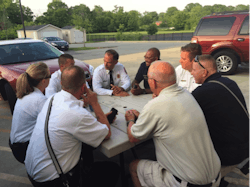What are the differences between a successful fire/EMS officer and a less-than-successful one? For those who are familiar with the TV program “The Dog Whisperer,” what makes Cesar Milan successful? In this article, we’ll connect the principles of the Dog Whisperer to the Fire Chief Whisperer through several factors—knowing your “craft,” maintaining a professional demeanor, exuding confidence, and recognizing that there are few cookie-cutter people or solutions.
I recognize that “success” may be measured in different courts of opinion and scales of perception. Let’s focus on what I’ll call the “middle-of-the-road organizations,” where the majority of the positive performance and work gets done. These organizations and their leaders are not mediocre; they’re on target.
Before we cover the characteristics of a true Fire Chief Whisperer, let’s consider those who do not fit this mold—the bullies and the I-WOTHs (In-Way-Over-Their-Heads). I’m quite sure each of us can quickly identify the bullies in our officer ranks; likewise, I’m sure we can quickly identify the I-WOTHs within our ranks.
Success for the bully, the I-WOTH and the whisperer are all first measured in the court of public opinion and perception, but ultimately weighed in the scale of reality and production. Why does each of these types of folks make it into the ranks they achieve? How does each of them succeed? And where do you and your organization “fit”?
In the January 2015 Chief Concerns column titled “What Does Leadership Look Like?,” I spoke about four types of people: leaders, managers, followers and slugs. We’ll relate how each “rank” interacts and succeeds or fails with the leaders we’re talking about today.
The Bully
With respect to leadership positions, the bully can best be described as the “squeaky wheel that gets the grease.” There are likely bullies within each rank of your organization, some more recognizable than others. The bully is loud, boisterous, blustery, belligerent. The managers and followers either become afraid of the bully or ultimately acquiesce to their bellicose persona, if for no other reason than just to get them to shut up and go away.
There are two kinds of people who are truly comfortable around the bully: 1) other bullies who consider themselves at some level equal and 2) slugs, who hide behind the distractive atmosphere the bully creates. There is no proper place for the bully within the public safety arena. The bully might be “salvageable” and could be productive to the organization; however, the time and energy necessary to manage and/or affect change with the bully has to be weighed on the scale of benefit for the public and the organization. It might just be time for the bully to go away.
The I-WOTH
The I-WOTH carries a very similar dynamic for leadership development. While we would all hope that the I-WOTH would have developed into a true leader as they came into rank, something likely affected their ability or capacity to develop before they were placed. I’ll submit to you that most I-WOTHs are salvageable; however, the organizational leaders have to use that same benefit scale in determining how much capital they will invest with the I-WOTH. Whether paid or volunteer, we must ensure that there is a clear career-development path for folks to follow. Simple elections or appointments without a succinct path and assessment create a path to disaster. You might get lucky and appoint that visionary hiding-in-the-rough; however, a learning environment with benchmarks and assessments provides the opportunity for and basis to validate your process.
Managers will try to work with the I-WOTH; however, in the absence of solid leadership, managers operating under unsalvageable I-WOTHs usually give up or take their own path. While they might get lucky with their chosen path, giving up and/or going forward without a plan or leadership is essentially “planning to fail.” Followers want to follow a plan; they crave structure and purpose.
Followers operating under an unsalvageable I-WOTH risk becoming slugs! If the I-WOTH is indeed salvageable, the managers will likely be the path toward the I-WOTH becoming a true leader. Shown promise, the managers will directly or indirectly help mold and build the salvageable I-WOTH. As long as the managers and followers under them continue “doing the right things,” the I-WOTH has a chance.
Slugs will be comfortable with the I-WOTH, at least as long as the I-WOTH is unsalvageable! Where better for a slug to hide than behind someone who’s equally “in-over-their-head”? The I-WOTH is the worst kind of leader for a slug to have. The I-WOTH will inadvertently validate and negatively empower the slug. A salvageable I-WOTH, on the other hand, will be liked by the slug in the beginning; however, as the I-WOTH evolves into a leader, the slug either matures to become a follower, sinks further under their rock, or they leave.
Note: A Political I-WOTH got their position because they knew (or are related to) somebody important. Appointment/promotion of the Political-I-WOTH is one of the surest ways to destroy morale and reduce positive production from the rest of the team. We must create an environment that encourages learning and development, as opposed to the silver-spoon political path or the destructive bully environment of fear.
Fire Chief Whisperers
We should strive to create Fire Chief Whisperers, and I don’t mean fire chiefs who literally whisper. The whisperer has immersed themselves in the field. They started “on the back step” (there’s a whole generation that doesn’t get that reference; help them out here). They cleaned the toilets and washed the dishes. They made and admitted their mistakes. They followed the career development path. They took all the classes. They achieved local and national certifications. They were always part of the solution. The whisperer asked and continues to ask questions. They took new folks under their wing. They listened and they helped others learn the way. They became part of the community—not just part of the fire department. They recognized change as not only inevitable but also necessary. They know the ins-and-the-outs politically and fiscally. They are not flamboyant; however, they’re not shy about being in front of the camera or microphone. They create an environment where people WANT to follow—not one where they feel compelled to follow out of fear or hopelessness. They became what people incorrectly term a “natural born leader.” Excepting fleeting political kingdoms, I submit to you there is no such thing as a “natural born leader.” Leaders develop and evolve; they are NOT born.
The whisperer has continued their educational path. They might not have a formal degree; however, their immersed combination of experience and education gives them the edge others don’t have. True managers crave having this kind of leader—someone who gives them room and “a reason to believe.” Managers have the best chance to evolve and develop as leaders when they work for/with a whisperer.
Slug production will be all over the place under a whisperer. Depending on how many slugs you have, the whisperer only has so many hours in the day to deal with incompetence. The slugs that WANT to be part of the team will become followers. The slugs that just want to be slugs need to leave under the Whisperer. There is little room.
In sum
Leaders develop and evolve into the whisperers who we’re talking about. Providing a clear career-development path and maximizing opportunities along the way will ensure the best path for everyone to develop into a true Fire Chief Whisperer—one who knows their craft, maintains a professional demeanor, exudes confidence (i.e., command presence) and recognizes/develops people for who they are, not for who the fire chief WANTS them to be.
About the Author

Marc S. Bashoor
MARC S. BASHOOR joined the fire service in 1981. In 2017, he retired as fire chief of Prince George’s County, MD, Fire/EMS, the largest combination department in North America. His progressive community-based approach led to record hiring and a strategic apparatus replacement plan.
Twitter: @ChiefBashoor
Email: [email protected]
